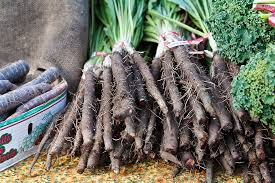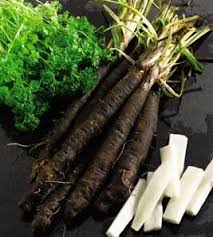While traditional root vegetables like carrots and parsnips are always a kitchen staple, adding unique varieties like salsify and scorzonera can introduce new flavors and textures to your meals. Often overlooked, these two Mediterranean gems are both easy to grow and offer a delightful departure from the usual suspects. Though they belong to the lettuce family, they are distinct in appearance and flavor, with salsify featuring pink flowers and scorzonera boasting yellow blooms. Let’s explore how to grow and cook these fascinating root vegetables.
Salsify: The Oyster Plant
Salsify, sometimes known as the “oyster plant,” resembles a long, slender parsnip with creamy flesh hidden beneath a dark-tan skin. It earned its name for its mild, oyster-like flavor, making it a unique addition to soups, stews, and roasted dishes. In addition to its edible roots, salsify’s pink flowers make it a beautiful ornamental plant, and the new shoots in spring can be eaten as greens, adding to its versatility.
This vegetable thrives in light, well-drained soil and is easier to grow than carrots or parsnips. Salsify needs plenty of sunlight and space to develop its long taproots, but with minimal effort, it can thrive in your garden.

Scorzonera: The Black Salsify
Scorzonera, or black salsify, is distinguished by its dark, black skin, which requires peeling before consumption. The roots can grow up to 3 feet long, providing impressive yields. Known for its slightly stronger flavor compared to salsify, scorzonera is just as simple to grow and is often favored by those who enjoy a more robust taste. Like salsify, it thrives in sunny, well-drained soil and benefits from similar care.
Growing Salsify and Scorzonera
To grow both salsify and scorzonera, start by sowing seeds in spring, once the soil has warmed. Plant seeds about 1.5 cm deep and space them 30 cm apart. Patience is key, as seedlings can take up to three weeks to appear. Once they do, thin them to leave 15 cm between plants, ensuring they have enough space to grow.
Both vegetables are relatively low-maintenance. Simply keep weeds under control, and water during dry spells. These roots can be left in the ground throughout winter, as the cold enhances their flavor. However, if you live in an area where the ground freezes, harvest them before the frost and store them in damp sand for later use.

When it’s time to harvest, take care when lifting the brittle roots. Use a fork to loosen the soil around the roots, working gently to avoid snapping them.
Cooking Salsify and Scorzonera
Both roots release a sticky latex when peeled, so it’s best to cook them first. Boil them for 10-20 minutes to soften the skin, making it easier to remove.
Salsify is incredibly versatile. Once peeled, it can be used in stews, soups, or sautéed with garlic, parsley, cream, and a touch of nutmeg for a rich, flavorful dish. You can also mash or roast the roots as you would with other root vegetables.
Scorzonera is often compared to asparagus in terms of texture and flavor. After boiling and peeling, coat the roots in a creamy hollandaise or white sauce for an indulgent treat. Alternatively, try deep-frying the roots for a crispy, savory snack.
Final Thoughts
Whether you’re looking for a new challenge in the garden or a unique twist for your meals, both salsify and scorzonera are worth exploring. Their easy growing conditions and delightful flavors make them a welcome addition to any vegetable garden or dinner plate. If you’ve tried growing or cooking with these roots, share your experiences in the comments below!
